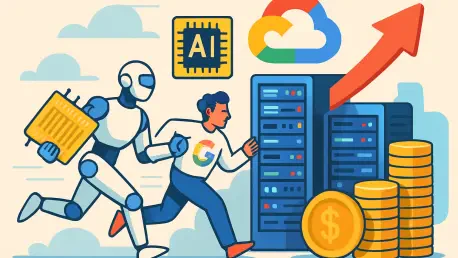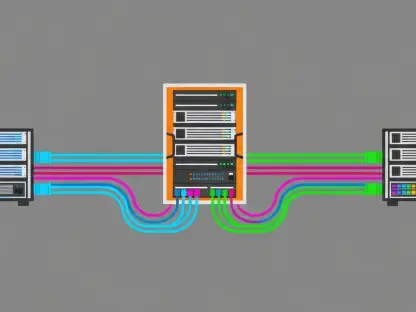Investors questioned whether the AI surge had outrun fundamentals even as usage spiked, but inside Google the mandate hardened around a simple, audacious rule: double compute capacity every six months or risk ceding the platform shift to faster movers with deeper pipelines and fewer bottlenecks. The target sounded more like a physics problem than a budget line, yet it framed a concrete response to mounting pressures on product rollouts, cloud onboarding, and model training queues. Leadership set a tone that paired urgency with discipline—build harder, not just bigger—and linked spend to engineering outcomes. That balance mattered because compute was not an abstract constraint; it had already shaped which features shipped, who got access, and how quickly revenue could be recognized across an expanding backlog.
The Mandate And Strategic Framing
The internal directive, delivered at a November 6 all-hands by Amin Vahdat, mapped a path to roughly a 1,000x capacity gain in four to five years, compressing improvement into a metronome of six-month doublings that left little room for drift. The message was less about outspending rivals than out-executing them, with reliability, performance, and scalability positioned as the true yardsticks. In this view, compute was the chokepoint throttling product ambition, and the only durable fix was an infrastructure stack that scaled predictably under real-world load. The strategy framed investment as a means to unblock demand already visible in customer pipelines, rather than a speculative land grab.
That framing also tied capital to craft. Vahdat underscored engineering discipline as the hedge against waste, pointing to tighter integration between infrastructure teams and frontier research that could forecast the next wave of model needs before they arrived. Sundar Pichai reinforced the risk calculus: underinvesting during a platform shift invited lasting opportunity loss, while overbuilding could be managed with the right cost curves and a diversified business. The aim was an architecture that delivered better tail-latency behavior, higher cluster utilization, and graceful scaling across training and inference—all signals of quality that compound faster than raw dollars.
Custom Silicon, Power, And The Cost Curve
The seventh-generation Tensor Processing Unit, codenamed Ironwood, sat at the center of the efficiency playbook, embodying gains that outpaced general-purpose hardware since the first Cloud TPU in 2018. The ambition reached beyond speedups: achieve thousandfold capability at roughly the same cost and increasingly within the same power envelope. That target acknowledged where the real boundary lay. Data center expansions now collided with energy availability, grid constraints, and the rising cost of every additional watt, forcing performance-per-watt to carry as much weight as absolute throughput. Silicon became the lever to stretch the envelope without breaking it.
Hardware alone would not close the gap, however. Google pushed improvements in interconnect topology, compiler stacks, scheduling, and orchestration to lift utilization and reduce tail costs, turning cluster-wide coordination into a multiplier on chip gains. The approach favored vertical integration: DeepMind’s research informed the accelerator roadmap; the accelerator shaped software optimizations; the software unlocked better total cost of ownership. That loop translated directly to product reality. Compute rationing had already limited offerings like Veo video generation inside Gemini, and each percentage point of efficiency recovered meant more users onboarded and fewer features gated by scarcity.
Spend, Signals, And The Market Cycle
Alphabet lifted its 2024 capital expenditure outlook to $91–93 billion and signaled a significant increase in 2026, aligning with a hyperscaler buildout that topped $380 billion this year across Microsoft, Amazon, and Meta. The spending was presented as offense and defense in one stroke: gain share by meeting demand where it already existed, and prevent revenue slippage caused by constrained capacity. Pichai pointed to 34% year-over-year growth in Google Cloud to more than $15 billion and a $155 billion backlog, arguing those figures masked upside that more compute could have unlocked. In other words, the cost of delay had tangible revenue effects.
Market sentiment offered a volatile backdrop. After strong Nvidia results, stocks still wobbled and “AI bubble” talk grew louder, a reminder that expectations could swing faster than forecasts adjusted. CFO Anat Ashkenazi acknowledged capex outpacing operating income but described the spend as table stakes for moving customers off on-premises infrastructure and monetizing AI with enterprise-grade SLAs. Pichai called 2026 “intense,” recognizing inevitable cycles while pointing to balance sheet strength as the buffer that let Google invest through turbulence. The bet hinged on execution: convert backlog, raise utilization, and translate reliability into durable share gains.
What Came Next For Sustainable Scale
The immediate to-do list translated this posture into execution. The most actionable levers were power-aware: data center siting gravitated toward regions with expandable capacity; partnerships with utilities and renewable providers secured predictable energy; and hardware targets prioritized performance-per-watt alongside memory bandwidth and interconnect efficiency. On the software side, the fastest wins were compiler optimizations, job packing, quantization, and selective sparsity—measures that had already reclaimed stranded capacity. Success metrics were less theatrical than model demos: backlog conversion rates, product availability flags, and reductions in throttling offered cleaner reads on progress than headline FLOPs.
For customers, the implications were practical. Pricing predictability depended on the cost curve bending down; availability windows depended on cluster reliability; and ramp timing depended on how quickly Ironwood-class capacity came online. Meanwhile, leadership signaled that volatility in market sentiment would not redirect the roadmap. The focus remained on compute as the scarce resource, on efficiency as the compounding advantage, and on disciplined capex as the bridge from research promise to production reality. In this frame, the next phase favored builders who aligned silicon, software, and power planning, because that alignment had defined who scaled and who stalled.









